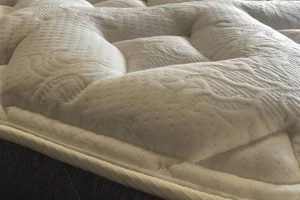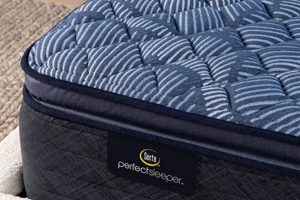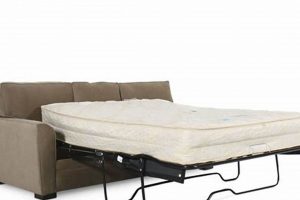The mechanism responsible for adjusting the firmness of a Sleep Number bed utilizes an air pump to inflate or deflate internal air chambers. This device, typically included with the bed, allows users to customize the support level to their individual preferences. It functions by introducing or removing air from the mattress’s integrated bladders, thus altering its overall feel and comfort.
Proper operation of this inflation system is crucial for realizing the advertised benefits of a Sleep Number bed, namely personalized comfort and support. A functional unit ensures the user can precisely control the mattress’s firmness, potentially leading to improved sleep quality and reduced pressure points. Historically, such adjustable airbeds offered limited control; however, advancements in pump technology now enable incremental and repeatable adjustments.
The subsequent sections will detail the various components of this system, common troubleshooting steps, and alternative solutions available to maintain optimal bed performance. Further discussion will address compatibility issues and offer guidance on extending the lifespan of the system.
Optimizing Performance
The following guidelines address the maintenance and effective utilization of the system designed to control the firmness of adjustable air mattresses. Adherence to these recommendations can contribute to prolonged equipment life and consistent performance.
Tip 1: Proper Placement: Ensure the control unit is positioned on a flat, stable surface, free from obstruction. Adequate ventilation is essential for heat dissipation and optimal operational efficiency.
Tip 2: Secure Connections: Verify all tubing connections are firmly secured to both the mattress and the control unit. Loose connections can lead to air leaks and inaccurate firmness settings.
Tip 3: Regular Inspection: Periodically inspect the tubing for signs of wear, cracks, or kinks. Damaged tubing should be replaced promptly to prevent air loss and system malfunction.
Tip 4: Gradual Adjustments: When altering firmness levels, make incremental adjustments rather than drastic changes. This approach minimizes stress on the internal air chambers and the control units motor.
Tip 5: Power Surge Protection: Utilize a surge protector to safeguard the control unit from electrical fluctuations, which can damage sensitive electronic components.
Tip 6: Timely Filter Replacement: If the control unit incorporates an air filter, adhere to the manufacturer’s recommended replacement schedule. A clean filter ensures efficient airflow and prevents dust accumulation within the system.
Tip 7: Humidity Control: Avoid operating the system in environments with high humidity. Excessive moisture can contribute to internal corrosion and premature equipment failure.
By implementing these preventative measures, users can optimize the functionality and extend the service life of their adjustable air mattress’s firmness control system. Consistent adherence to these guidelines will contribute to a more reliable and comfortable sleep experience.
The subsequent sections will delve into troubleshooting common issues and exploring available replacement options.
1. Functionality
The functionality of a Sleep Number mattress inflator directly dictates the user’s ability to customize the mattress’s firmness. A malfunctioning unit renders the adjustable feature inoperable, negating a primary selling point of the bed. This dependency highlights functionality as a critical component; without it, the mattress essentially becomes a standard, non-adjustable model. The ability to inflate or deflate the air chambers is the core function that enables users to achieve their preferred comfort level.
Consider a scenario where the inflation mechanism fails. The user is then unable to increase or decrease the air pressure within the mattress, resulting in a fixed level of firmness that may not align with their needs or preferences. This directly impacts sleep quality, potentially leading to discomfort and disrupted rest. Another example is a slow-responding or inconsistent inflator, which makes achieving precise firmness settings difficult, thus reducing the benefits of personalized support. Functionality extends beyond mere operation; it also encompasses the responsiveness and accuracy of the system.
In summary, the functionality of the Sleep Number mattress inflator is paramount to realizing the bed’s intended purpose. Its operational efficacy directly affects the user’s ability to adjust firmness and achieve optimal sleep comfort. Any impairment in functionality significantly diminishes the value proposition of an adjustable air mattress, underscoring the necessity for reliable components and proper maintenance. This understanding is crucial for both consumers and manufacturers in ensuring the longevity and effectiveness of the overall sleep system.
2. Compatibility
Compatibility is paramount when considering a Sleep Number mattress inflation system. These systems are often designed for specific models and generations of Sleep Number beds. A mismatch can result in either complete system failure or suboptimal performance, compromising the adjustability and intended comfort of the mattress. The cause and effect relationship is straightforward: incompatible components lead to impaired functionality.
Consider a scenario where a user purchases a replacement inflator marketed as a generic solution. While it may connect physically, the control protocols or pressure ranges could differ significantly from the original equipment manufacturer’s specifications. This discrepancy can lead to inaccurate pressure readings, inconsistent firmness levels across the mattress zones, or even damage to the mattress’s internal air chambers due to over-inflation. The practical significance lies in understanding that not all inflation systems are created equal; choosing a compatible unit ensures seamless integration and accurate operation.
The need for compatibility extends beyond mere physical connections. It encompasses the software and electronic control systems that govern the inflation process. Mismatched control signals or firmware versions can render the system unusable, highlighting the importance of verifying the part number and model compatibility before any purchase. The consequences of ignoring this aspect range from minor inconveniences to significant financial losses. Prioritizing compatibility is, therefore, a critical aspect of maintaining the optimal performance and longevity of a Sleep Number bed. The correct inflator guarantees to function with the mattress.
3. Airflow Control
Airflow control is an intrinsic aspect of the system that regulates the firmness of adjustable air mattresses. The efficiency with which air is transferred to and from the internal chambers directly influences the speed and precision of firmness adjustments. Inadequate airflow control results in sluggish response times, hindering the user’s ability to quickly achieve their desired comfort level. For example, a restricted valve or a weak pump can significantly prolong the inflation or deflation process, diminishing the user experience.
The design of the airflow system within an adjustable air mattress directly impacts the uniformity of support. Uneven airflow distribution can lead to pressure imbalances within the mattress, creating uncomfortable pressure points or localized areas of excessive firmness. These imbalances negate the intended benefits of personalized support and can compromise sleep quality. Proper airflow control ensures consistent and even inflation across the entire mattress surface. Furthermore, optimal airflow reduces strain on the motor and other components, potentially extending the overall lifespan of the system. Blockages or obstructions in the airflow pathway can cause the motor to work harder, increasing the risk of premature failure.
Effective airflow control is essential for the overall functionality and user satisfaction. Deficiencies can lead to a range of issues, from slow response times to uneven support and premature system failure. Consequently, careful attention to the design, maintenance, and troubleshooting of the airflow components is critical for ensuring the long-term performance and reliability of adjustable air mattress systems.
4. Pressure Accuracy
Pressure accuracy is a critical performance parameter for any system designed to adjust the firmness of a Sleep Number mattress. The system’s ability to deliver and maintain a specified pressure level directly influences the user’s perception of comfort and support. If the control unit displays a “Sleep Number” of 40, but the actual internal pressure deviates significantly from the calibrated value for that setting, the user will not experience the intended level of firmness. This discrepancy negates the personalized comfort the bed is designed to provide and can lead to dissatisfaction. A miscalibrated sensor or a leaky valve are causes for pressure inaccuracy. The intended effect is ruined when the pressure is inconsistent.
The practical consequences of inaccurate pressure readings extend beyond mere discomfort. Consistently incorrect pressure settings can lead to improper spinal alignment, exacerbating existing back pain or contributing to new musculoskeletal issues. For example, a user requiring a firm setting for optimal support might inadvertently sleep on a softer-than-indicated surface due to pressure inaccuracies. This prolonged misalignment can result in chronic pain and discomfort. Precise control unit function helps to support comfort. Furthermore, pressure accuracy is essential for repeatable and consistent sleep experiences. If the same “Sleep Number” setting yields different firmness levels on subsequent nights, the user loses confidence in the system’s ability to deliver reliable support.
In conclusion, pressure accuracy is an indispensable aspect of the Sleep Number mattress inflation system. Its direct impact on comfort, spinal alignment, and the consistency of sleep experiences underscores its importance. Overlooking this factor compromises the value proposition of personalized comfort and potentially leads to negative health outcomes. Regular calibration checks and addressing any signs of pressure instability are essential steps in maintaining the functionality and effectiveness of the system. Therefore, a precise inflation unit is integral to a Sleep Number bed.
5. Motor Reliability
Motor reliability constitutes a critical factor in the overall performance and lifespan of the device responsible for adjusting the firmness levels within Sleep Number mattresses. The motor powers the inflation and deflation process, and its consistent operation directly influences the user’s ability to customize their sleep experience. Premature motor failure renders the entire system inoperable, negating the adjustable features that define the Sleep Number bed.
- Duty Cycle and Thermal Management
The duty cycle, representing the proportion of time the motor is actively engaged, impacts the motor’s operational temperature. Extended periods of inflation or frequent adjustments increase the thermal load, potentially leading to overheating and premature wear. Effective thermal management strategies, such as integrated cooling fans or heat sinks, are essential for maintaining stable operating temperatures and extending motor lifespan. Without adequate heat dissipation, the motor’s performance degrades, and the risk of failure increases significantly. This is especially true for users who frequently adjust their mattress settings.
- Component Quality and Manufacturing Tolerances
The quality of the individual components within the motor, including windings, bearings, and commutators, directly influences its operational longevity. Substandard materials or imprecise manufacturing tolerances can lead to increased friction, accelerated wear, and diminished performance. Motors constructed with robust materials and adhering to stringent quality control standards exhibit superior reliability and resistance to failure. Motors with lower quality parts might work initially, but quickly degrade, resulting in costly repairs.
- Voltage Stability and Electrical Protection
Fluctuations in the supplied voltage can subject the motor to undue stress, potentially causing damage to its internal components. Overvoltage conditions can lead to insulation breakdown and winding failure, while undervoltage scenarios can result in reduced torque and erratic operation. Incorporating voltage regulation circuitry and surge protection mechanisms safeguards the motor from electrical anomalies and promotes consistent performance. Protecting against electrical surges is key to maintaining long-term function.
- Maintenance and Environmental Factors
While the inflation system is generally low-maintenance, external factors such as dust accumulation and ambient humidity can impact motor reliability. Dust particles can impede airflow, exacerbating thermal stress and potentially causing mechanical damage. High humidity levels can promote corrosion of internal components, accelerating wear and increasing the risk of electrical shorts. Regular cleaning of the surrounding area and protection from excessive moisture contribute to optimal motor performance and extended lifespan. The cleanliness of the surrounding area is just as important as the function of the motor itself.
The facets discussed highlight the interconnectedness of design considerations, material quality, and environmental factors in determining motor reliability within Sleep Number mattress inflation systems. Attention to these aspects translates to increased product longevity, reduced maintenance requirements, and enhanced user satisfaction. The dependability of the Sleep Number system relies directly on the consistent performance of its integral motor component, thus making motor reliability of utmost importance.
6. Hose Integrity
Hose integrity directly impacts the performance of a Sleep Number mattress inflation system. The hoses, typically constructed from flexible polymers, serve as the conduits for air transfer between the control unit and the mattress’s internal air chambers. Any compromise in hose integrity, such as leaks, cracks, or kinks, disrupts the pressure regulation essential for achieving the desired firmness level. Hose integrity is essential for inflating the bed. These degradations causes a degradation in the functionality of the Sleep Number mattress.
Consider a scenario where a small puncture develops in one of the hoses. This seemingly minor defect allows air to slowly escape, preventing the system from maintaining the set pressure. The user might notice a gradual softening of the mattress over time, requiring more frequent adjustments to compensate for the leakage. In more severe cases, a complete hose rupture renders the system entirely inoperable, preventing any inflation or deflation. Kinks in the hose can severely restrict airflow, leading to slow and inconsistent pressure changes. Such airflow restrictions hinder the responsiveness of the system. Maintaining hose integrity guarantees to maintain a mattress’s functionality.
In summary, hose integrity is an indispensable component of the Sleep Number mattress inflation system. Compromised hoses introduce pressure instability, diminish system responsiveness, and can ultimately lead to system failure. Regular inspection and prompt replacement of damaged hoses are critical for ensuring the long-term functionality and reliability of the adjustable air mattress. Preserving hose integrity is a preventative measure, guarding against the degradation of the intended sleeping experience. Sleep Number mattresses are completely dependent on hose function.
Frequently Asked Questions
The following addresses common inquiries regarding the device used to adjust the firmness of Sleep Number mattresses. The information is intended to provide clarity and guidance on proper usage and maintenance.
Question 1: What is the expected lifespan of the Sleep Number mattress inflator?
The lifespan varies depending on usage frequency and environmental conditions. Under normal circumstances, the inflation system should function effectively for several years. However, factors such as excessive use, exposure to dust or humidity, and power surges can shorten its operational life. Adhering to recommended maintenance practices can significantly extend the unit’s longevity.
Question 2: Is it possible to replace the Sleep Number mattress inflator with a third-party device?
While third-party options exist, compatibility is not guaranteed. Sleep Number inflation systems are often proprietary and designed to function specifically with their mattresses. Using an incompatible device can result in improper pressure regulation, system malfunction, or even damage to the mattress. Consulting the manufacturer is advisable before considering alternatives.
Question 3: What are common signs of a failing Sleep Number mattress inflator?
Common indicators include slow or unresponsive inflation/deflation, unusual noises during operation, error messages displayed on the control unit, and an inability to maintain the desired firmness level. These symptoms suggest a potential malfunction requiring investigation or replacement.
Question 4: How frequently should the Sleep Number mattress inflator be serviced?
The inflation system generally requires minimal maintenance. However, regular inspection of the hoses and connections is recommended to identify potential leaks or damage. If the unit incorporates an air filter, adhering to the manufacturer’s recommended replacement schedule is essential for optimal performance.
Question 5: What safety precautions should be observed when operating the Sleep Number mattress inflator?
The inflation system should be connected to a surge protector to safeguard against electrical fluctuations. Avoid operating the unit in damp or humid environments. Do not attempt to disassemble or repair the device without proper expertise, as this can pose an electrical hazard and void the warranty.
Question 6: Where can a replacement Sleep Number mattress inflator be obtained?
Replacement units can typically be purchased directly from Sleep Number or authorized retailers. When acquiring a replacement, ensuring compatibility with the specific mattress model is paramount. Providing the mattress model number and system serial number can assist in identifying the correct replacement unit.
Consistent maintenance and cautious operation are key to the systems lifespan.
The next section will address troubleshooting common issues encountered with the inflatable functionality of mattresses.
In Summary
The preceding sections have comprehensively examined the mechanism responsible for pressure control within Sleep Number mattresses. Aspects such as functionality, component compatibility, airflow regulation, pressure accuracy, motor durability, and hose integrity have been individually assessed to underscore their respective contributions to the system’s overall performance and reliability. Thorough understanding of each element is crucial for maintenance.
Given the inherent reliance on this pressure control system for personalized sleep comfort, proactive maintenance and informed decision-making regarding replacements are essential. The long-term satisfaction of Sleep Number mattress owners hinges on the sustained operability of this vital component. Its consistent and correct use guarantees a reliable system, thus ensuring a comfortable experience.







